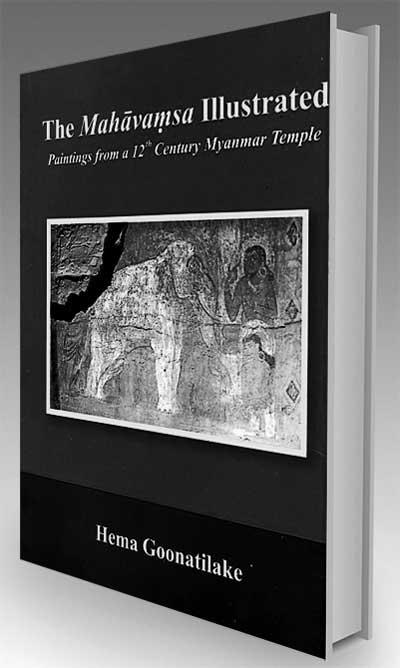25 Mar 2019 - {{hitsCtrl.values.hits}}

 The book turns back the pages of Lankan History to a lesser known scenario when Sinhala bhikkhus set sail across the Indian Ocean, reached Burma then known as Ramanna and expanded Sinhala Theravada Buddhism which gave way for Sinhala cultural motifs to take root in South East Asia. The Sangha Sasana by then had been resuscitated in 1071 by Vijayabahu 1 (1055-1110CE) of Polonnaruwa after it disappeared with the Cola rule of 78 years. The Sangha evidently thereafter, had embarked with new vigour in spreading Buddha’s Teachings which resulted in drawing close two Buddhist civilisations in the 11th and the 12th centuries.
The book turns back the pages of Lankan History to a lesser known scenario when Sinhala bhikkhus set sail across the Indian Ocean, reached Burma then known as Ramanna and expanded Sinhala Theravada Buddhism which gave way for Sinhala cultural motifs to take root in South East Asia. The Sangha Sasana by then had been resuscitated in 1071 by Vijayabahu 1 (1055-1110CE) of Polonnaruwa after it disappeared with the Cola rule of 78 years. The Sangha evidently thereafter, had embarked with new vigour in spreading Buddha’s Teachings which resulted in drawing close two Buddhist civilisations in the 11th and the 12th centuries.
Lankan historical episodes documented in the Mahavamsa, being depicted on the walls of the ancient Burmese Temple Miyankaba Kubyankgyi relates the triumphs of missionary work of these Sinhala bhikkhus and the cultural enrichment it had brought about in South East Asia.
A specialist in Buddhist Studies and the only woman to have become President of the 173-year-old Royal Asiatic Society, Dr Goonatilake, on her discovery that Mahavamsa had inspired ancient mural painters of Burma, has captured in her heavily illustrated monograph whatever that remains of the paintings. Faded, yet the story visible, the paintings are eloquent evidence of the strong cultural bonds that had existed between the two countries. The depicted Mahavamsa episodes include the well-known encounter of Thera Mahinda with Devanam Piyatissa, the enshrining of relics in Ratana Cetiya by Dutugamunu, Theri Sanghamitta’s arrival in Sri Lanka and even the mother cow ringing the bell which illustrates Elara’s enforcement of justice among many other historic events.
The book also contains photographs of old Buddhist viharas and Chetiya in the ancient Burmese Capital city of Bagan that show Lankan influence in the Buddhist architecture. Its text, which relates the history of the era from the 11th to the 12th centuries reflects what extent Sri Lankan culture had steeped into the then Burmese society. Buddhism during this period had been taught in Sinhala and almost all Buddhist texts of Sri Lanka had been studied in Myanmar while the Mahavamsa had been the model Buddhist text in Myanmar and in some other parts of South East Asia.
Lankan historical episodes documented in the Mahavamsa is depicted on the walls of the ancient Burmese Temple Miyankaba Kubyankgyi relates the triumphs of missionary work of these Sinhala bhikkhus and the cultural enrichment it had brought about in South East Asia
Links between the two countries are traced to a much earlier era. Professor Rohanadeera (2003) read an old inscription dated 550-650ce in Thailand, then part of ancient Ramanna which referred to a group of people from Anuradhapura having settled as a community in the ancient city of Dvaravati.
 The author, however, focuses on the interactions between the two countries that intensified about 500 years later when Lankan bhikkhus made inroads to Bagan, then the Capital. How was this brought about? In the 11th and the 12th centuries, there emerged a new dimension in politics when sea routes used for trade, linked with South East Asian countries and China. These countries which were searching for a new identity were reaching out to establish new political ties when Sri Lanka established political relations with South East Asian countries. Especially Myanmar was looking to Sri Lanka for inspiration in its classic Pagan period of the 11th to the 13th centuries. This made way for religious and cultural links.
The author, however, focuses on the interactions between the two countries that intensified about 500 years later when Lankan bhikkhus made inroads to Bagan, then the Capital. How was this brought about? In the 11th and the 12th centuries, there emerged a new dimension in politics when sea routes used for trade, linked with South East Asian countries and China. These countries which were searching for a new identity were reaching out to establish new political ties when Sri Lanka established political relations with South East Asian countries. Especially Myanmar was looking to Sri Lanka for inspiration in its classic Pagan period of the 11th to the 13th centuries. This made way for religious and cultural links.
The first reference to Myanmar in the Culavamsa relates to envoys being sent by Vijayabahu 1 of Polonnaruwa to Anawrahta (Anuruddha,) the king of Ramanna seeking assistance to defeat the Colas. The author refers to Anawrahta sending “many ships” to Sri Lanka in response to the call. Once the Colas were driven away, a religious mission of twenty bhikkhus had arrived on Vijayabahu’s request for the Higher Ordination towards the reestablishment of the Sangha Sasana in Sri Lanka.
Dr Goonatilake refers to the contention of some scholars such as Paranavitana, Godakumbura and Sirisena that the monks who arrived should be Sinhala monks who had fled Sri Lanka during the Cola rule. She argues that the Higher Ordination conferred on Sinhala monks had not been described by the place of origin as was done in the case of Siam, Ramanna or Amarapura Nikaya. Or, as Sinhala Sangha when monks from Sri Lanka conferred Higher Ordination on Burmese monks and Lankavamsa when Thai, Cambodian and Laos received Sri Lankan Ordination.
Dr Goonatillake gives credit to Gordon Luce who pronounced in 1961 that the temple paintings of Kubyankgyi were illustrations of Mahavamsa. Details of these paintings he had explained at the time, however, have since decayed. Emeritus Professor Y. Karunadasa and Donald M. Stadtner, formerly Associate Professor, University of Texas have written the Foreword and the Introduction respectively which set the stage for the lively discussion.
The mural paintings had begun shortly after the expedition of Parakramabahu1when he sent a fleet to Ramanna. Disputes, however, have been overcome when missionary work of Lankan bhikkhus had intensified in present Burma and Thailand as well as Cambodia, Laos, South Vietnam and the Yunnan Province in China. The depiction of Mahavamsa on the Temple walls had commenced in the 12th century during the reign of Anawrahta’s grandson, Rajakumar of Ramanna.
Sinhala bhikkhus in the meantime taught Pali, the language of the Tripitaka and Theravada Buddhism. They introduced Sinhala forms of sculpture, architecture, literature and paintings to the region. Dipavamsa and Mahavamsa inspired chronicle writing in the South East Asian region with historical records of South Asia modelled after Mahavamsa. Symbols such as images of Buddha and the Bodhi Tree, originating from Sri Lanka, became key aspects for political legitimization in the South Asian region, developments that can be attributed to the impact of missionary work of Lankan bhikkhus.
30 Nov 2024 12 minute ago
29 Nov 2024 29 Nov 2024
29 Nov 2024 29 Nov 2024
29 Nov 2024 29 Nov 2024
29 Nov 2024 29 Nov 2024